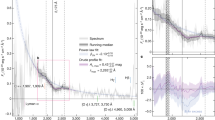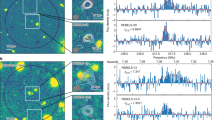Abstract
Large amounts of dust (>108M⊙) have recently been discovered in high-redshift quasars1,2 and galaxies3,4,5 corresponding to a time when the Universe was less than one-tenth of its present age. The stellar winds produced by stars in the late stages of their evolution (on the asymptotic giant branch of the Hertzsprung–Russell diagram) are thought to be the main source of dust in galaxies, but they cannot produce that dust on a short enough timescale6 (<1 Gyr) to explain the results in the high-redshift galaxies. Supernova explosions of massive stars (type II) are also a potential source, with models predicting 0.2–4M⊙ of dust7,8,9,10. As massive stars evolve rapidly, on timescales of a few Myr, these supernovae could be responsible for the high-redshift dust. Observations11,12,13 of supernova remnants in the Milky Way, however, have hitherto revealed only 10-7–10-3M⊙ each, which is insufficient to explain the high-redshift data. Here we report the detection of ∼2–4M⊙ of cold dust in the youngest known Galactic supernova remnant, Cassiopeia A. This observation implies that supernovae are at least as important as stellar winds in producing dust in our Galaxy and would have been the dominant source of dust at high redshifts.
This is a preview of subscription content, access via your institution
Access options
Subscribe to this journal
Receive 51 print issues and online access
$199.00 per year
only $3.90 per issue
Buy this article
- Purchase on Springer Link
- Instant access to full article PDF
Prices may be subject to local taxes which are calculated during checkout




Similar content being viewed by others
References
Bertoldi, F. et al. Dust emission from the most distant quasars. Astron. Astrophys. Lett. (in the press); also available at http://www.arXiv.org/astro-ph/0305116 (2003).
Archibald, E. N. et al. A submillimetre survey of the star formation history of radio galaxies. Mon. Not. R. Astron. Soc. 323, 417–444 (2001)
Hughes, D. H. et al. High-redshift star formation in the Hubble Deep Field revealed by a submillimetre-wavelength survey. Nature 394, 241–247 (1998)
Smail, I., Ivison, R. J. & Blain, A. W. A deep sub-millimetre survey of lensing clusters: A new window on galaxy formation and evolution. Astrophys. J. 490, L5–L8 (1997)
Dunne, L., Eales, S. A. & Edmunds, M. G. A census of metals at high and low redshifts and the connection between submillimetre sources and spheroid formation. Mon. Not. R. Astron. Soc. 341, 589–598 (2003)
Morgan, H. L. & Edmunds M. G. Dust formation in early galaxies. Mon. Not. R. Astron. Soc. (in the press); also available at http://www.arXiv.org/astro-ph/0302566 (2003).
Todini, P. & Ferrara, A. Dust formation in primordial Type II supernovae. Mon. Not. R. Astron. Soc. 325, 726–736 (2001)
Clayton, D. D., Liu, W. & Dalgarno, A. Condensation of carbon in radioactive supernova gas. Science 283, 1290–1292 (1999)
Kozasa, T., Hasegawa, H. & Nomoto, K. Formation of dust grains in the ejecta of SN 1987A. II. Astron. Astrophys. 249, 474–482 (1991)
Woosley, S. E. & Weaver, T. A. The evolution and explosion of massive stars. II. Explosive hydrodynamics and nucleosynthesis. Astrophys. J. Suppl. Ser. 101, 101–181 (1995)
Lagage, P. O. et al. Dust formation in the Cassiopeia A supernova. Astron. Astrophys. 315, L273–L276 (1996)
Douvion, T., Lagage, P. O., Cesaesky, C. J. & Dwek, E. Dust in the Tycho, Kepler and Crab supernova remnants. Astron. Astrophys. 373, 281–291 (2001)
Dwek, E., Dinerstein, H. L., Gillet, F. C., Hauser, M. G. & Rice, W. L. Physical processes and infrared emission from the Cassiopeia A supernova remnant. Astrophys. J. 315, 571–579 (1987)
Lucy, L. B., Danziger, I. J., Gouiffes, C. & Bouchet, P. in Supernovae: The 10th Santa Cruz Workshop in Astronomy and Astrophysics (ed. Woosley, S. E.) 82 (Springer, New York, 1991)
Reed, J. E., Hester, J. J., Fabian, A. C. & Winkler, P. F. The three-dimensional structure of the Cassiopeia A supernova remnant. I. The spherical shell. Astrophys. J. 440, 706–721 (1995)
García-Segura, G., Langer, N. & MacLow, M.-M. The hydrodynamic evolution of circumstellar gas around massive stars. Astron. Astrophys. 316, 133–146 (1997)
Holland, W. S. et al. SCUBA: a common-user submillimetre camera operating on the James Clerk Maxwell Telescope. Mon. Not. R. Astron. Soc. 303, 659–672 (1999)
Gotthelf, E. V. et al. CHANDRA detection of the forward and reverse shocks in Cassiopeia A. Astrophys. J. 552, L39–L43 (2001)
Wright, M., Dickel, J., Koralesky, B. & Rudnick, L. The supernova remnant Cassiopeia A at millimeter wavelengths. Astrophys. J. 518, 284–297 (1999)
Li, A. & Draine, B. T. Infrared emission from interstellar dust. II. The diffuse interstellar medium. Astrophys. J. 554, 778–802 (2001)
Agüeros, M. A. & Green, D. A. The bulk expansion of the supernova remnant Cassiopeia A at 151 MHz. Mon. Not. R. Astron. Soc. 305, 957–965 (1999)
Borkowski, K. J., Szmkowiak, A. E., Blondin, J. M. & Sarazin, C. L. A circumstellar shell model for the Cassiopeia A supernova remnant. Astrophys. J. 466, 866–870 (1996)
Reichart, D. E. & Stephens, A. W. The fading of supernova remnant Cassiopeia A from 38 MHz to 16.5 GHz from 1949 to 1999 with new observations at 1405 MHz. Astrophys. J. 537, 904–908 (2000)
Baars, J. W. M., Genzel, R., Pauliny-Toth, I. I. K. & Witzel, A. The absolute spectrum of CAS A—an accurate flux density scale and a set of secondary calibrators. Astron. Astrophys. 61, 99–106 (1977)
O'Sullivan, C. & Green, D. A. Constraints on the secular decrease in the flux density of CAS A at 13.5, 15.5 and 16.5 GHz. Mon. Not. R. Astron. Soc. 303, 575–578 (1999)
Mason, B. S. et al. An absolute flux density measurement of the supernova remnant Cassiopeia A at 32 GHz. Astron. J. 118, 2908–2918 (1999)
Liszt, H. & Lucas, R. 86 and 140 GHz radiocontinuum maps of the Cassiopeia A SNR. Astron. Astrophys. 347, 258–265 (1999)
Mezger, P. G., Tuffs, R. J., Chini, R., Kreysa, E. & Gemuend, H.-P. Maps of Cassiopeia A and the Crab Nebula at lambda 1.2 mm. Astron. Astrophys. 167, 145–150 (1986)
Saken, J. M., Fesen, R. A. & Shull, J. M. An IRAS survey of Galactic supernova remnants. Astrophys. J. Suppl. Ser. 81, 715–745 (1992)
Tuffs, R. J., et al. in The Universe as Seen by ISO (eds Cox, P. & Kessler, M. F.) 241–254 (ESA-SP 427, ESA Publications Division, ESTEC, Noordwijk, 1999)
Acknowledgements
We thank M. Wright for providing us with the 83-GHz image, and W. Gear and D. Green for discussions. L.D. is supported by a PPARC postdoctoral fellowship and H.M. by a Cardiff University studentship. We are grateful to G. Davis for the use of Director's time on the JCMT to obtain the new photometry data.
Author information
Authors and Affiliations
Corresponding author
Ethics declarations
Competing interests
The authors declare that they have no competing financial interests.
Rights and permissions
About this article
Cite this article
Dunne, L., Eales, S., Ivison, R. et al. Type II supernovae as a significant source of interstellar dust. Nature 424, 285–287 (2003). https://doi.org/10.1038/nature01792
Received:
Accepted:
Issue Date:
DOI: https://doi.org/10.1038/nature01792
This article is cited by
-
The underexposed effect of elastic electron collisions in dusty plasmas
Communications Physics (2021)
-
Dust in Supernovae and Supernova Remnants I: Formation Scenarios
Space Science Reviews (2018)
-
Tests and Problems of the Standard Model in Cosmology
Foundations of Physics (2017)
-
Hot Dust in Ultraluminous Infrared Galaxies
Astrophysics (2017)
-
A dusty star-forming galaxy at z = 6 revealed by strong gravitational lensing
Nature Astronomy (2017)
Comments
By submitting a comment you agree to abide by our Terms and Community Guidelines. If you find something abusive or that does not comply with our terms or guidelines please flag it as inappropriate.



